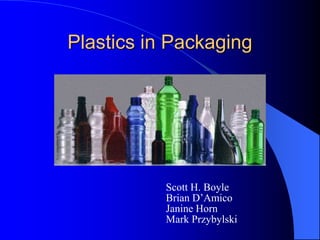
PlasticsPackaging.ppt
- 1. Plastics in Packaging Scott H. Boyle Brian D’Amico Janine Horn Mark Przybylski
- 2. What Will be Discussed Definition of a plastic. Overview of the packaging industry. Why plastics are used in packaging. A detailed look at the different types of plastics used in packaging. How plastics compare to alternative materials. Environmental Impacts
- 3. What is a Plastic? A plastic is defined as an organic material that has the ability to flow into a desired shape when heat and pressure are applied and to retain that shape when they are withdrawn. Composed primarily of a binder with- • Plasticizers • Fillers • Pigments • Other additives
- 4. Industry Overview World sales of primary packaging materials estimated to be $434 billion in 2001. • Up 12.5% from $385 billion in 1997. World sales of finished packaging materials is estimated to be $800 billion. Four main categories of raw packaging materials: • Paper and Board • Glass • Metal • Plastic Over the past few years, plastic has become increasingly popular.
- 5. Why Plastics? A wide variety of different qualities- – Rigid vs. Flexible – Clear vs. Opaque Lightweight Strong Cost
- 6. Which Plastics are Used? Six resins account for almost 97 percent of all plastic used in packaging. Polyethylene terephthalate (PET) – 9% High-density polyethylene (HDPE) – 29% Low-density polyethylene (LDPE) – 32% Poly-vinyl chloride (PVC) – 5% Poly-propylene (PP) – 11% Polystyrene (PS) – 11%
- 7. Polypropylene Physical Properties – Durable High elongation – 300% High Tensile Strength – 4500 psi High Yield Strength – 4000 psi – High Melting point – Low Density Lowest density of all plastics used in packaging
- 8. Why Polypropylene? Practicality – Inexpensive – Chemically resistant – Ideal for holding hot liquids – Stretchy vs. rigid Many everyday uses – Ketchup bottles – Peanut butter jars
- 9. Polyvinyl Chloride Need Title Chemically non-reactive Flexible vs. Rigid Self Extinguishing Plasticized vs. Unplasticized – Plasticized is more flexible
- 10. Why PVC Versatile – Can be machined with standard metal working tools Self Extinguishing – Used to house electrical wiring Many forms – Sheet – Tubing – Piping
- 11. Polyvinylidene Dichloride Discovered in 1933 – Accidental Discovery – Original use was to stop corrosion on airplanes – After a green color and a pungent smell had been removed it was used for food storage. Most common form of PVDC is Saran Wrap®
- 12. Why PVDC PVDC is a very effective food preservation method. – Co-polymerization used in synthesis creates a very tight molecular chain Provides good barrier against air and moisture. Chemically non-reactive – Ensures that food won’t taste like plastic
- 13. Plastic vs. The Alternatives Stress Strengths 100 550 30 1000 50 100 19 25 0 200 400 600 800 1000 St ress St rengt h ( M Pa) Aluminum Alloy Glass Wood (Oak) Plastic (PE) M at erial Stress Strengths of Packaging Materials Minimum Maximum
- 14. Plastic vs. The Alternatives Incredibly lightweight 2 lbs of plastic can deliver 1000 oz. of liquid. To carry the same amount it would take: • 3 lbs of aluminum • 8 lbs of steel • 27 lbs of glass Compared to glass, plastic drink bottles allow a distribution truck to carry up to 63% more drink and 83% less packaging. Compared to paper, 7 trucks are needed to deliver the same quantity of paper bags contained in one truckload of plastic bags.
- 15. Plastic vs. The Alternatives Cost As of mid-2000, PET was selling for app. $.62/lb. Around the same time, aluminum alloy was selling for app. $1.28/lb. – Plastic reduces distribution costs- • Decrease in necessary truckloads • Fuel savings – Reduces lost inventory costs.
- 16. Plastic vs. The Alternatives Environment Impact Plastics are recycled less frequently than glass and aluminum. Plastics are not biodegradable.
- 17. Plastic vs. The Alternatives Environmental Impact Plastic also has a positive impact on the environment. Consider the following fact: – When comparing the manufacturing processes of polystyrene and paper cups, it was found the the paper cups use: • 15 times more chemicals. • More than 6 times more steam. • 13 times more electricity. • 30% more cooling water. • 170 times more process water. The lightweight nature of plastics results in fewer truckloads and less fuel usage.
- 18. Recycle (cont.) Recycling process – Collection – Sorting – Reclamation
- 19. Recycle (cont.) Benefits – Less landfill waste – Environmentally friendly
- 20. Recycle Statistics – >80% of all US households have access to plastic collection and recycling programs – In 1998 plastic bottle packaging amassed 1.45 billion pounds by volume Commonly recycled plastics – Plastic Grocery Bags – Plastic Milk Jugs and Detergent Bottles – Plastic Beverage Containers
- 21. Reuse (cont.) Good Examples – Large reusable containers Small packages of concentrated product are bought and diluted to large container Reduces product packaging cost, landfill space – Reusable Plastic Shipping Containers (RPSC’s) Replaces single use containers Reduces shipping/receiving costs, landfill space
- 22. Reusing and Recycling Plastic Packaging Reuse – Statistics – Commonly reused plastic packaging – Benefits – Good Examples Recycle – Statistics – Commonly recycled plastic packaging – Recycling Process – Benefits
- 23. Reuse Statistic – A 1997 survey found 80% of Americans reuse plastic products and packaging Common Reusable Packaging – Plastic Grocery Bags – Plastic Milk Jugs and Detergent Bottles – Plastic Beverage Containers
- 24. Reuse (cont.) Benefits – Good Properties Long lasting Durable Chemically inert – Delays filling of landfills – Lowers cost of garbage disposal
- 25. In Summary Plastics – Lighter …..……………………………. – Cheaper …………... – More Durable ………………………
- 26. Questions???